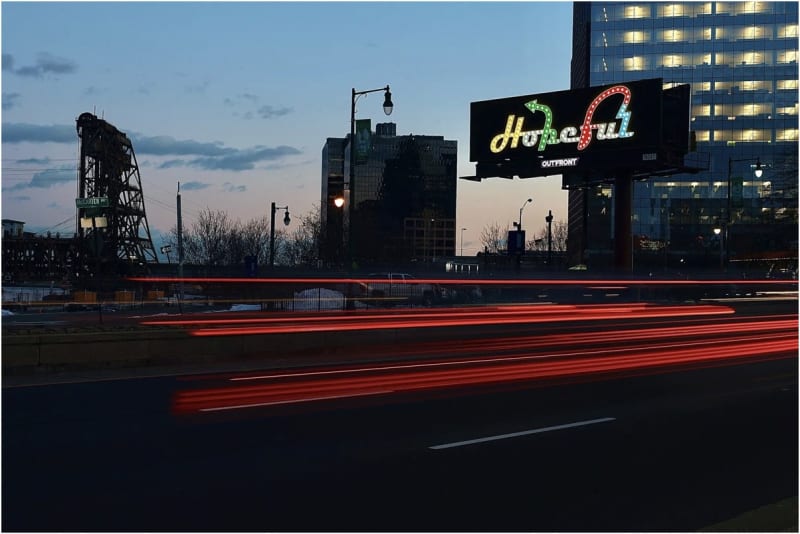In the beginning, the word was the problem, Charlie Hewitt said. There are so many words — 171,476 in the Oxford English Dictionary, not counting 47,156 listed as obsolete. Hewitt, an artist from Portland, Maine, needed only one. The one that came to mind was “hopeful.”
He felt it was the right word for the moment.
He created four sculptures with the seven-letter word in a typeface that was an exuberant throwback to the 1950s. He installed them on buildings in Maine and exported the idea to the New York area, spending about $40,000 to rent billboards in New Jersey that carried images of one of the sculptures. One billboard loomed over the helix to the Lincoln Tunnel, and another over McCarter Highway in Newark. Soon “Hopeful” will take up residence on a billboard near the New Jersey Performing Arts Center, also in Newark.
Yet another sculpture is visible on 23rd Street in Chelsea, through the window of Jim Kempner Fine Art, at 501 West 23rd Street. It is not far from the Hewitt’s “Urban Rattle” sculpture, installed in 2012 in the courtyard of Ten23, an apartment building next to the High Line. He said he hoped that “Hopeful” would find homes in other places and has started a digital campaign to spread the, um, word.
He sees “Hopeful” as dynamic and uplifting. He wants “Hopeful” to inspire compassion in a world now fatigued by the pandemic and politics, although the inspiration struck in 2019, a time he described as “prepandemic and mid-Trump.” He said he felt “alienated in my tribe, over in my corner, safe in my narrative, throwing rocks at the other narratives on the other side.” He was also “missing that world in the middle,” he said.
“Somewhere in Bill Clinton’s world, that’s where my politics were,” he said. Of people with different views, he said, “I think I’m more like them than they think I am.”
“Hopeful” took Hewitt, 75, back to an even earlier time of bipartisan politics. “It represented the car culture, the Route 66 phenomenon — that thing became so important to me as a young hippie, getting out to see the world. And, also, it had a kind of patina to it in terms of the rusting and the weather and the lights that were out. A ‘Hotel Baltimore’ kind of phenomenon.” “Hot l Baltimore’ was a Lanford Wilson play that inspired a short-lived sitcom in the 1970s about a timeworn residential hotel with a neon sign that had lost an E.
Hewitt won’t let that happen to the “Hopeful” sculpture in Portland. “I got an email last week that a light bulb is out on that piece,” he said. “I got a light bulb and a ladder and went and changed the light bulb.”

